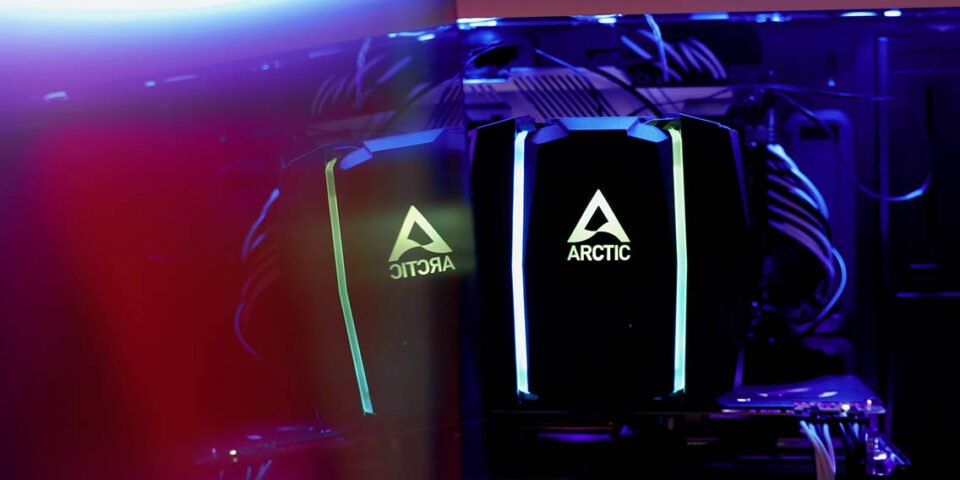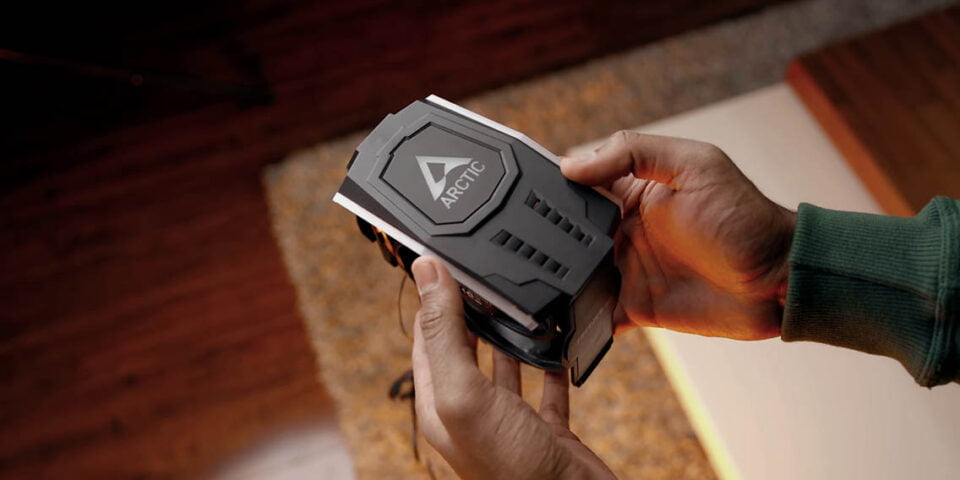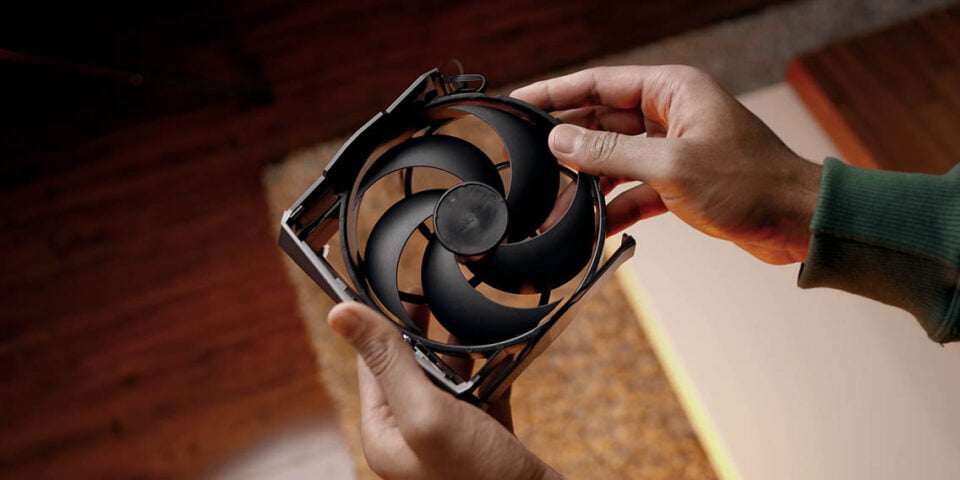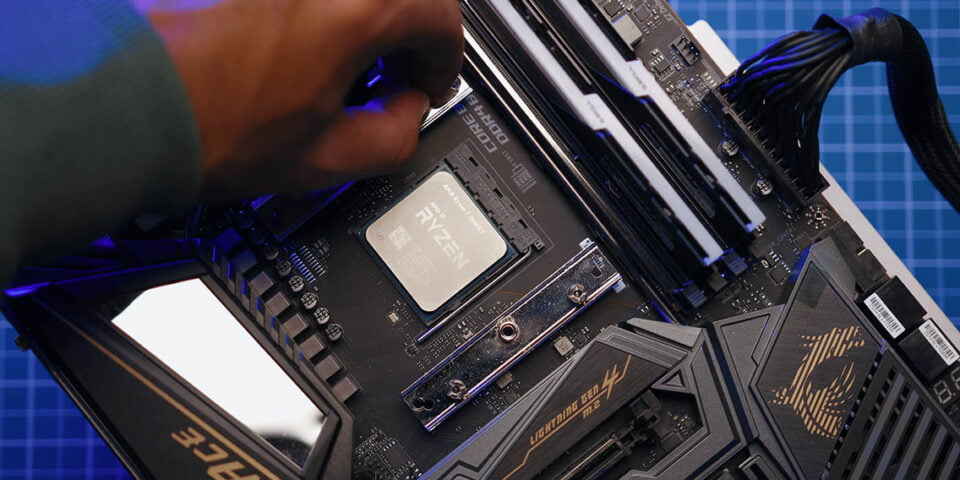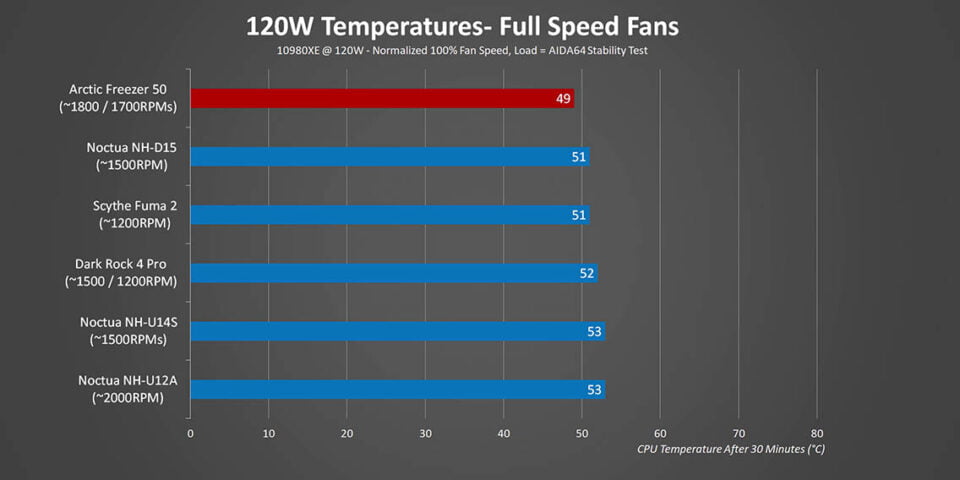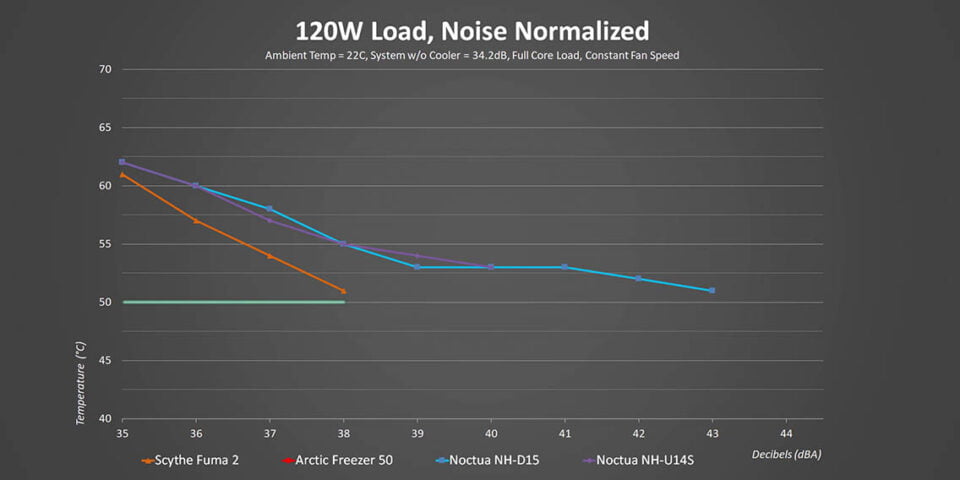This CPU Cooler is SO GOOD – Arctic Freezer 50 Review

Share:
Table of contents
It has been about a month since we looked at an air cooler. The last one that we did was the Cooler Master MA620M, which was a great looking cooler with a stealth design. Its performance was all right, it wasn’t the greatest, but it was designed for a very specific type of audience. With the Zen 3 launch right around the corner I’m sure a lot of you are planning out a new build and you might be looking for components that can go along with that. There haven’t been a lot of air coolers launched lately, because a lot of the companies are focusing on their all-in-one liquid cooling solutions, which we will be doing a roundup review of perhaps in early 2021.
Today I want to talk about the Arctic Freezer 50, and it makes some pretty big claims like supposedly being quieter than established coolers like the Noctua NH-D15, Scythe Fuma 2, and the be quiet! Dark Rock Pro 4, while also offering better cooling performance. The bigger story here is the fact that the Freezer 50 has a starting price of $75 USD, and Arctic claims that is the best air cooler in the market right now. We are going to put those claims to the test.
I’m going to start off by saying that Arctic has a special place in the hearts of everyone here at Hardware Canucks because they were the first company to send us a review sample back in the days when we were doing written reviews on the website almost 15 years ago. Back then it was their original Accelero X1 GPU heatsink, and ever since then Arctic has been known for providing an awesome combination of performance and value.
Price & Design
A $75 USD the Freezer 50 competes price-wise with the NH-U14S though it’s more expensive than our value champion the $60 Scythe Fuma 2. On the other hand, Arctic’s wider distribution may give them a leg up on the Fuma 2, since that cooler is almost impossible to find in some regions. There is also an $85 model of the Freezer 50 with an included A-RGB controller in case your motherboard doesn’t have the necessary header for all that LED lighting goodness.
At first glance, the Freezer 50 gives off Corsair A500 vibes because most of the heatsink is encased in gobs of plastic to the point where it feels well sort of cheap. You also need to know that a lot of those plastic bits have functional purposes too. According to Arctic, beside trying to direct airflow between the two cooling towers, the front and back pieces contribute to better air movement and lower noise levels. The top cover houses the addressable RGB components, which illuminate two thin strips and the huge Arctic text right in the middle. I’m okay with the smaller lines of RGB, but I think that logo is way too big and it can’t be controlled separately from the other lighting systems.
Potential Issues
The nice thing about Scythe, be quiet!, and Noctua coolers is that they don’t need branding all over the place to make an impression. The main problem I have with this design is that it doesn’t allow you to change any of the fans. The 120mm intake fan is literally built into a shroud, which is then attached to the heatsink with a bunch of plastic clips. There is also a centrally mounted 140mm fan that is permanently attached to the top cover. According to Arctic the Freezer 50 was designed specifically for these two fans air flow characteristics. Now that does make sense, but if one of them ever has a problem the whole cooler or entire center section would need to be replaced. Arctic’s warranty does cover you for 6 years, but that does seem wasteful for a company that is making a big deal about being environmentally friendly.
Another consequence of all this plastic is that it causes some compatibility issues. The two side shrouds can’t be moved upwards, which means memory modules that are taller than 37.5mm won’t fit under the fan shroud. That means most RGB enabled modules like our G.Skill Trident Z’s don’t fit, so obviously we had to swap them out with a Corsair LPX kit. The plastic bits also increase the overall size way past what this cooler would normally be. It is 166mm tall, 149.5mm wide, and 148mm long. That actually makes it a bit larger than the be quiet! Dark Rock Pro 4, but it is only half a millimeter taller than Noctua’s NH-U14S so compatibility with most cases shouldn’t be a problem.
Once the center fan is removed you can see that Arctic has gone with a dual tower design, but unlike Corsair they did it properly with that central 140mm fan working to both pull and push air through the second fin array. Those towers are hooked up to six large 6mm heatpipes that end in a HDT base. I want to focus on that base since it is something that is typically used on lower end air coolers. One of its main problems is it’s really hard to manufacture this type of contact plate so that it aligns properly with the CPU’s IHS. We saw this issue with the Corsair A500, but it looks like Arctic avoided those problems since this one is really well finished.
Installation
As for installation, well it is pretty straightforward. What I really like is that they found a way to use common hardware for most of the different sockets. For example, the main mounting crossbars and thumb nuts are used for both AMD and Intel systems, with the only real difference being each socket type has its own standoffs. Also on AMD you will be reusing your motherboards backplate, while there is one provided for Intel’s LGA1150 and LGA1200 motherboards. My only real issue here is that Arctic gives you enough thermal compound for a single application, and the squeeze packet is a pain in the butt to use. In order to save on paper Arctic didn’t include an instruction manual, but there is a QR code which you can scan that brings you to a really well done installation tutorial that is on their website.
Since the installation process is pretty much the same for every system let’s focus on AMD’s AM4 platform. All you have to do is attach the standoffs to the backplate, put the crossbars in place, and then tighten down the nuts. At this point the back plate is going to feel a little loose, but don’t worry since the screws on the Freezer 50 are designed to tighten everything up. After that it’s just a simple matter of screwing the cooler down, and remounting the center fan assembly. That assembly has a simple Y splitter, so both fans can be plugged into the same motherboard fan header. The only real issues we ran into was getting the centerpiece attached to the cooler, you have to push it down really hard to make sure it latches back into place. Once it’s on it actually makes contact with our GPUs backplate, pushing it downwards. Luckily that will only be a problem on very specific motherboards that have the primary PCIe slot super close to the CPU socket.
Now there are a few interesting things I want to mention too. First of all, Arctic recommends that thermal compound be applied in four separate lines running perpendicular to the heatpipes. We are going to be using that method for our testing. Also, I do need to mention that the HDT base doesn’t make complete contact with the IHS on AMD or Intel LGA2066 CPUs. That might lead to some excess heat not getting dissipated, but let’s see if that’s the case during testing. Speaking of testing, click here if you want to go over our full testing methodology, since it is evolving again in this review to include some decibel normalized cooling performance.
120W Thermal Testing
Let’s start off with our usual benchmarks, at a lower 120W thermal load, and using the motherboard’s default fan profile. The Freezer 50 jumps out to a super quick lead. In the past I have talked about how HDT bases are super efficient at lower heat levels when they are done right, and it looks like that is what is happening here. The only trade-off is that the motherboard seems to be pushing a bit more aggressive fan speed profile to get those lower temps, so let’s move on to a real apples-to-apples comparison at a 1,000 RPMs.
At this point, the Freezer 50 has pretty similar temperatures to the NH-D15 and the Dark Rock Pro. This is really good news for a lot of users, since most CPUs fall within the thermal range of this test. Now we are seeing some impressive results since these temperatures actually come with lower noise, at least at this wattage.
Cranking up the fans to 100%, and the Freezer 50 starts narrowly beating the NH-D15 and even other coolers in the charts. That performance does come at the sacrifice of noise, but what’s really interesting is while the Freezer 50’s fans are operating at higher RPMs than many of the other heatsinks their noise profile is really respectable. Those plastic shrouds might look cheap, but they could be reducing this cooler’s noise output.
165W Thermal Testing
Moving up to 165W, and it still gets great temperatures when using the ASUS standard fan profile, but it’s also still one of the louder options. However, since the default profile is different for every motherboard and situation use these tests as a rough estimate of behavior. Like I said before, the RPM normalized results are a better judgment of raw performance and here the Freezer 50 starts falling behind a bit, though it still beats the NH-U12A. Just remember that Arctic is doing this at a lower noise level than the other coolers. Now look it’s not like you want to run any of these at full speed, but if you do expect to see NH-D15 matching temperatures at 165W.
265W Thermal Testing
Switching over to 265W, and you can see that it’s super impressive to see the Freezer 50 hanging on right below the NH-D15. It even gets to that level with a similar noise level too, and in this situation I can’t really say that the ASUS fan profile is too aggressive. Moving down to lower RPMs and you can see that this thing absolutely needs higher fan speeds or the heatsink quickly reaches its thermal limits. Boosting those RPMs lead to super competitive temperatures, but I doubt you would be able to stand the noise.
Noise Normalized Thermal Testing
Now let’s move on to some of our new tests that we are including in this review. It’s one of the tests that you have all been requesting in our past CPU cooler reviews: Decibel or noise normalized thermal testing. Essentially we are going to be showing you a bunch of data points in a single graph and that needs a little bit more explanation first.
Basically, noise normalized testing allows us to show how good a heatsink is able to cool at a given decibel level. In our charts, the X axis shows the decibel readings in one DB increments from 35 all the way up to whatever the maximum level is for the loudest cooler. We start at 35 dBA since our systems noise floor is 34.2 dBA with its intake and exhaust fans running. The Y axis shows the sustained CPU temperatures after a 30 minute test run. If you are wondering why we are not starting at zero it’s because most of the results would get to clustered together to see since there is only a few degrees separating the best from the worst results. So let’s add some results to this for the Scythe Fuma 2, the Noctua NH-D15, and the Noctua NH-U14S, and drill into those a bit. You can see that the NH-U14S and the NH-D15 get really similar temperature results, but the blue NH-D15 line extends further to the right. That is because it puts out higher decibel levels than the NH-U14S, but as noise increases it’s cooling gets a boost too. The Fuma 2 on either hand maxes out at just 38 dBA while also running cooler than the other two across every noise level. If you want a quick visual indicator of the best heatsink, it would be a bar that is low and short. I should also mention that the results start to even out at lower loads, regardless of fan speeds, since the CPU isn’t putting out enough heat to influence the cooling of higher end heatsinks.
Let’s add the Freezer 50 to this. It actually outperforms or matches the Fuma 2 at lower noise levels, and then manages to beat the NH-D15 as fan speeds increase. However, that is only at 120W. When we boost that up to 165W the Freezer 50 does get beaten at super low noise levels, but the second we moved to 36 dBA it ended up pretty much matching the NH-D15 and it beat the NH-U14S at comparable noise. At 265W heat levels the Fuma 2 and NH-U14S might be quiet, but they get totally overwhelmed. Meanwhile, the Freezer 50 tends to run hotter than the NH-D15, but it evens out at higher noise levels. So what does this all mean? Well the Arctic Freezer 50 is a super impressive heatsink that can match or beat the best of the best air coolers at lower heat loads. That means it is actually an awesome option for 90% of the market who are rocking Ryzen or Intel CPUs at stock or with mild overclocks. The fact that we are getting back into performance at a lower price is just the icing on the cake.
Conclusion
Now obviously the NH-D15S is still the King if you are rocking something like the i9-10900K or the i9-10980XE, especially if you are looking for an overall quieter system. If you are okay with a few small annoyances, like limited memory compatibility, the massive Arctic logo, and the inability to switch out the fans, the Freezer 50 gets a full recommendation from us. Great job Arctic.
Buy items in this review from Amazon at the links below:
Arctic Freezer 50 – https://geni.us/FREEZER50
Arctic Freezer 50 (ARGB) – https://geni.us/F50ARGB
Scythe Fuma 2 – https://geni.us/FUMA2
Noctua NH-U14S – https://geni.us/NHU14SC
Noctua NH-D15 – https://geni.us/NoctuaD15














